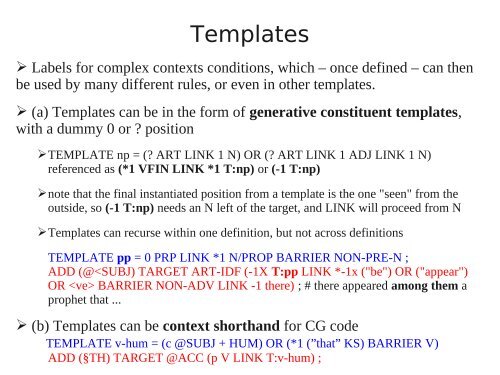On how to write rules in Constraint Grammar (CG-3) - VISL
On how to write rules in Constraint Grammar (CG-3) - VISL
On how to write rules in Constraint Grammar (CG-3) - VISL
You also want an ePaper? Increase the reach of your titles
YUMPU automatically turns print PDFs into web optimized ePapers that Google loves.
Templates<br />
➢ Labels for complex contexts conditions, which – once def<strong>in</strong>ed – can then<br />
be used by many different <strong>rules</strong>, or even <strong>in</strong> other templates.<br />
➢ (a) Templates can be <strong>in</strong> the form of generative constituent templates,<br />
with a dummy 0 or ? position<br />
➢TEMPLATE np = (? ART LINK 1 N) OR (? ART LINK 1 ADJ LINK 1 N)<br />
referenced as (*1 VFIN LINK *1 T:np) or (-1 T:np)<br />
➢note that the f<strong>in</strong>al <strong>in</strong>stantiated position from a template is the one "seen" from the<br />
outside, so (-1 T:np) needs an N left of the target, and LINK will proceed from N<br />
➢Templates can recurse with<strong>in</strong> one def<strong>in</strong>ition, but not across def<strong>in</strong>itions<br />
TEMPLATE pp = 0 PRP LINK *1 N/PROP BARRIER NON-PRE-N ;<br />
ADD (@
















